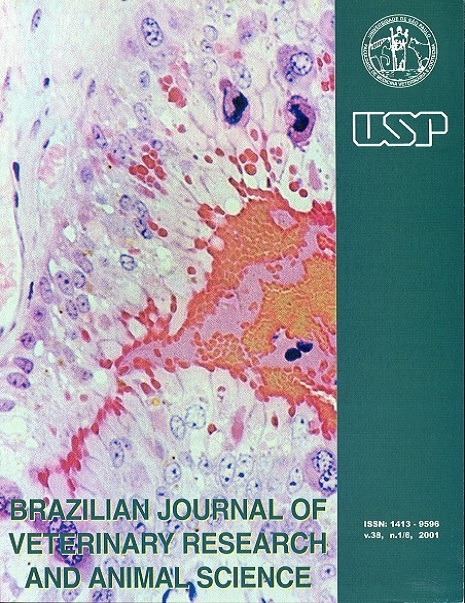Pelvimetry and pelvilogy in female mixed buffaloes (Bubalus bubalis)
DOI:
https://doi.org/10.1590/S1413-95962001000300004Keywords:
Buffaloes (anatomy), Buffaloes (pelvic measures), Pelvis, Morphometry, Pelvimetry, PelvilogyAbstract
In vivo internal and external pelvimetry was carried out in 255 mixed female buffaloes. A Menissier-Vissac pelvimeter was used for the internal measurements. The results were compared to age, heart girth, body weight, height and length. In order to compare the pelvic measurements, the animals were equitably divided into 3 groups (n=85) according to parturition occurrence and frequency (nuliparous, primiparous and multiparous). The internal transverse (horizontal) pelvic diameters, dorsal and ventral bi-iliac and the sacro-pubic (vertical) were respectively: 17.1 ± 2.17 cm; 15.7 ± 2.11 cm and 22.3 ± 2.51 cm; and the external bi-iliac (hipwidth), bi-isquiatic (pin width) and ilioisquiatic (rump length): 59.8 ± 6.13 cm; 32.4 ± 3.56 cm and 44.5 ± 3.31 cm, respectively. Significant positive correlations (p < 0.01) were obtained for all measurements but heart girth was found to have the highest correlations to pelvic measurements. Adjusted means by heart girth revealed significant differences (p < 0.05) for the 3 groups in respect to internal pelvimetry. However, as it concerns to external pelvimetry, significant differences were found only between the nuliparous and the other two groups for the bi-iliac and ilioisquiatic; for the bi-isquiatic diameter no significant differences were found. The internal pelvimetry was found to be less correlated to the body size and more evidently affected by the successive parturition occurrence.Downloads
Download data is not yet available.
Downloads
Published
2001-01-01
Issue
Section
BASIC SCIENCES
License
The journal content is authorized under the Creative Commons BY-NC-SA license (summary of the license: https://
How to Cite
1.
Oliveira CA de, Bombonato PP, Baruselli PS, Oliveira JFS de, Souza A de O. Pelvimetry and pelvilogy in female mixed buffaloes (Bubalus bubalis). Braz. J. Vet. Res. Anim. Sci. [Internet]. 2001 Jan. 1 [cited 2024 Apr. 18];38(3):114-21. Available from: https://www.revistas.usp.br/bjvras/article/view/5894





